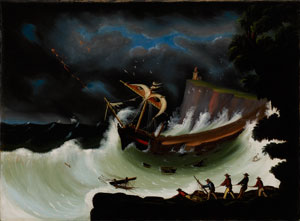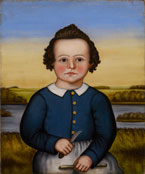For over a half-century (roughly 1760 to 1840), creative activity by untrained artists/artisans flourished in the United States. Their work enhanced the lives and captured the dreams of early Americans with a directness and simplicity that charms us today. While academically trained artists dominated artistic production in the major coastal cities such as Philadelphia and Boston, self-taught itinerant painters served the rising class of landowners, small businesspeople, and merchants who settled and prospered in the villages of rural America. Arduous transport in cramped coaches over rutted roads, nights spent in flea-infested inns, and bad food were some of the hurdles itinerant painters encountered in their endeavors to locate and serve the rural consumers of their day.
While folk painters provided their clients with the occasional decorative still life, marine, or landscape painting, it was portraiture that remained the financial bedrock of their existence. Graphic simplicity and standard poses and costumes were shortcuts that enabled the folk artist to maximize his or her modest fee with a minimal investment of time. The accompanying props—dresses, cashmere shawls, and jewels for the ladies; ships and telescopes for sea captains; Bibles for the village pastor; and expensive toys for the children—were elements of a succinct visual vocabulary employed to convey the sitter's status or profession.
The arrival of new technologies, improved roads, and railways, as well as the increased availability of magazines and journals, connected previously isolated communities to the larger world and to contemporary tastes and fashions. This heightened awareness transformed the expectations of the client and, in turn, demanded more sophisticated skills from the itinerant painter. Moreover, the introduction of photography, especially the daguerreotype, in the 1840s signaled the end to this early, golden era of folk art.





